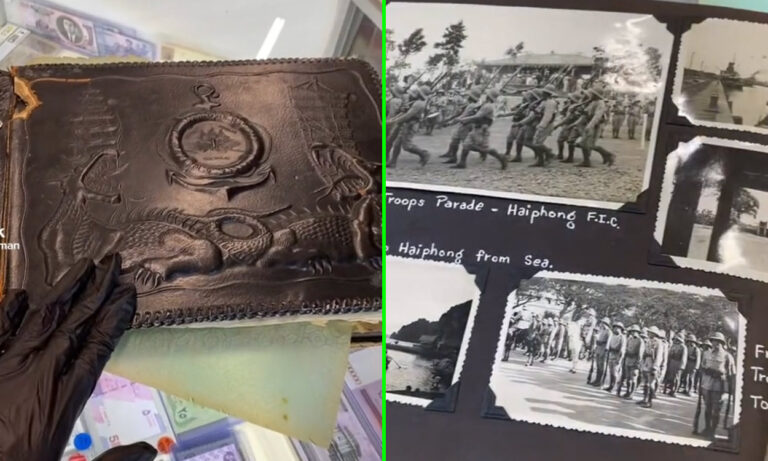Never seen before photographic evidence of the horrifying 1937 Nanjing massacre just discovered
Evan Kail, the owner of St. Louis Park Gold & Silver, a Minnesota precious-metal dealership, receives packages everyday. Most of them contain assorted coins, jewellery and other miscellaneous items—products to be expected in a pawn shop. On 29 August 2022, however, Kail received a once-lost historic artefact that has uncovered war crimes once believed to be non-existent.
According to The New Yorker, the 33-year-old man was searching through a box of items when he came across an album of wartime photographs. The album was leather-bound and featured two distinctive dragons on the front. The pictures inside appear to have been assembled by an American Navy sailor who had wanted to capture his tour of the western Pacific in the 1930s.
Kail decided to document his findings on his TikTok account @pawn.man, and viewers very quickly became horrified at the contents of the photo album. The video, which has now amassed over 30 million views, depicts the pawnshop owner flicking through the album and revealing the disturbing nature of the images inside.
The man explained how, at the beginning of the album, the US sailor has documented some incredibly vivid moments of life in the 1930s in South East Asia. However, the images quickly become something far more sinister. As the book starts to shift and display more war-related content, Kail turned the camera to his face and stated, “I can’t show you past this page.”
@pawn.man PLEASE HELP ME #nankingmassacre #historicalphotos #worldwar2 #pawnman #museumtreasure
♬ original sound - Pawn Master Kail
But it wasn’t long before the pages he referred to were posted on Twitter and the images inside depict what can only be described as “human carnage.” The photographs—which have since been taken down—capture the remains of bomb victims, a decapitated man, a charred and discarded cadaver and many more scenes of horror and massacre spill off of the pages—creating a far too realistic depiction of the suffering that took place. Graphic images of a Lingchi public execution—known by westerners as “death by a thousand cuts”—are even featured in the same.
But it wasn’t long before the pages he referred to were posted on Twitter and the images inside depict what can only be described as “human carnage.” The photographs—which have since been taken down—capture the remains of bomb victims, a decapitated man, a charred and discarded cadaver and many more scenes of horror and massacre spill off of the pages—creating a far too realistic depiction of the suffering that took place. Graphic images of a Lingchi public execution—known by westerners as “death by a thousand cuts”—are even featured in the same.
Locating the site of this destruction is also made possible by road signs displayed in many of the photographs. “Nanking road” can be spotted in the background, allowing us to accurately identify the site of these extreme atrocities of war.
For those of you who may be unaware, Nanking—now known as Nanjing—was the setting of a wide-scale massacre in 1937. Although often dismissed or downplayed by public officials, the ‘Rape of Nanking’ is a dark spot in history that should not be belittled or forgotten. The Chinese city was infiltrated by Japanese troops in December 1937 and, over a span of six weeks, bands of soldiers slaughtered, raped, pillaged and tormented its inhabitants.
It has been estimated that at least 20,000 women were raped with many of these victims brutally mutilated after their ‘purpose’ had been fulfilled. Bodies were discarded in bulk alongside rivers and the soldiers’ methods of execution grew deadlier each day, from hacking victims to death to covering them in petrol and burning them alive.
The Japanese government has consistently denied that the massacre ever took place. In 2000, The Guardian reported public outrage in response to a controversial conference held in Osaka, Japan titled The Verification of the Rape of Nanking: The Biggest Lie of the 20th Century.
While survivors of the massacre had gathered outside the conference, one victim, Liu Xiuling, stated, “They say I’m lying, I say I best represent the massacre victims because I still have wounds on my body, wounds on my face, wounds on my legs. Can you deny that?”
Since his discovery of the photo album, Kail has posted an update to his TikTok account explaining how he intends to locate a museum in China so as to ensure the book’s preservation and hopefully provide some concrete proof of this traumatic moment in history.
@pawn.man Update on my World War 2 photo book #worldwar2 #historytok #empireofjapan #pawnman
♬ original sound - Pawn Master Kail
It should be noted that, since Kail came forward with his findings, a number of prominent historians have questioned the validity of the images. The photographs, after having been posted on Twitter, were quickly queried by historian Jo Hedwig Teeuwisse, as reported by NBC News.
Teeuwisse, who has also acted as a historic consultant on a number of TV shows and movies, cautioned that while the album genuinely did appear to be from the 1930s, the included photos were potentially printed and widely distributed, which the soldier was likely to have bought and added to the album—thereby challenging the authenticity of the images and their place in the Nanking timeline.
Despite these possibilities, educating individuals about this historic event and recognising the atrocities that were committed is without a doubt a step in the right direction.






